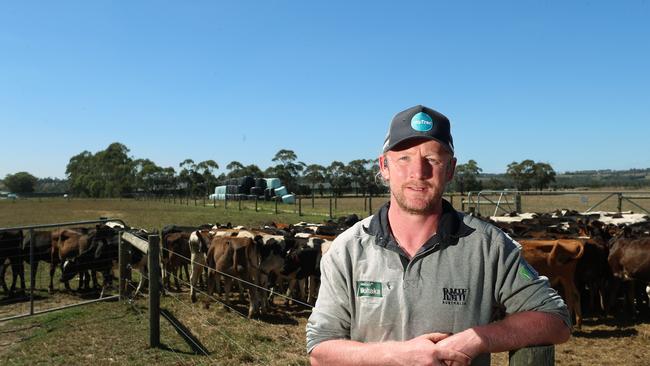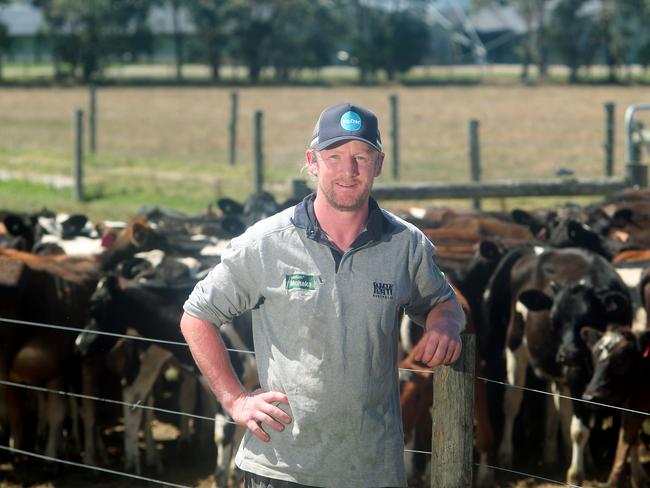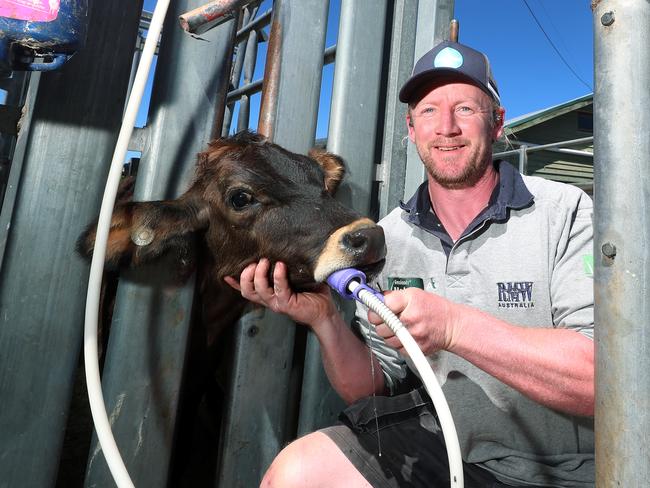Risk and reward for Moyarra dairy farmer Brian Corr
It wasn’t luck that resulted in young Irish-Australian dairy farmer Brian Corr’s rapid rise to farm ownership. This is how he did it.

Given his Irish descent, one could be forgiven for thinking it was all luck that Brian Corr was able to buy his own dairy farm, share farm another and build up to a 900 cow milking herd in the space of 2½ years.
But four leaf clovers and shamrocks had little to do with his good fortune.
A combination of being open to opportunities, taking calculated risks and a load of hard work did.
Brian wasn’t new to dairying when he bought the 155ha farm at Moyarra in South Gippsland in July 2022.
He grew up on a mixed farm in Ireland, studied dairying, managed farms in the UK and Ireland and spent time in New Zealand before a backpacking trip to Australia led to more career possibilities than he could have imagined, including a seven year stint on a dairy farm at Poowong.
“I only intended to come here for a year or two and move home to the family farm but once I’d been here a few years I could see there were so many good opportunities in dairy,” Brian said.
Coming from overseas, he appreciated the ease of being able to secure land in Australia and farm in a low cost system without the need for infrastructure like barns and concrete, essentials in Europe.
A STEEP RISE
The Moyarra farm is not typical prime dairy country.
It is hilly and steep but the price was right and the lower demand for land opened up other opportunities for Brian, 41, and partner Myrid Bartlett.
The couple were able to affordably lease another 85ha of milking area and 122ha to run their 600 head of young and replacement stock.
There is capacity to expand on both farms with hopes of increasing the milking herd to 1000 cows.
“Our Friesian-Jersey cross cows are quite small so 1000 head would probably be the equivalent of 800 average Australian cows,” Brian said.
“They get around the hills better. I think they are the best animal for the hills and slightly lower input systems with less grain than normal.”
The cows are fed between one and 1.2 tonnes of grain per cow per year. It is whole grain crushed on the farm.

Brian said they hadn’t looked back since taking the leap to farm ownership.
They started milking 400 cows in their first year, 500 in the second year and then most recently took on a share farm up the road with another 400 cows.
“It is a rapid rise,” Brian said.
“The share-farm came up way too soon for us but it was the same people we bought our farm off and it was only 10 minutes away.
“If we didn’t take it, someone else would and that opportunity would be gone forever so we managed to take it on too and we have no regrets, it has worked out well.”
TAKING ON TECH
Brian uses mostly New Zealand and Irish genetics in the herd, which he said suits their lower input system and the hills.
For the past two years they have trialled and now installed in the entire herd, Irish developed Moonsyst internal bolus technology – an electronic device that sits inside the cow’s rumen but doesn’t break down.
The bolus replaces the need for collars, detecting heat and health traits, water consumption and activity from individual cows.
“We were the first farm in Australia to trial it and are now one of multiple farms using it in the whole herd,” Brian said.
“We think it is a more accurate system and a lower cost option than collars.”
It costs about $120 per cow to install, half the price of a collar.
“We are hoping it will reduce our labour during breeding and allow us to use more sexed and beef semen so we can eliminate bobby calves,” he said.
They already use 90 per cent sexed semen on their predominantly spring calving herd.
Being in expansion mode has meant introducing 40-45 per cent heifers into the herd yearly to date, but that will drop back to 20-25 per cent once milking herd numbers stabilise.
Up to 50 beef cows and calves are also raised each year to help fund the purchase of extra milking cows and heifers.
“We do cull hard on udders, lameness, fertility and mastitis,” Brian said.

SOLID PRODUCTION
The crossbred herd on the home farm currently produces 400 kilograms milk solids per cow a year and the share farm herd produces 475kg milk solids per cow.
In their first season at Moyarra, production per farm was 151,000kg milk solids, last year it was 179,000kg milk solids and this year they are aiming for 200,000kg milk solids.
“We’d like to increase the production on the crossbreds but it is a very young herd because we’ve been expanding so rapidly and that is holding production down per cow,” Brian said.
“We don’t really focus on individual cow production though, it’s not relevant in our system. It’s about maximising the use of the land we have.”
They are trying to maximise the use of pasture in the cows’ diet and minimise the amount of costly imported hay, grain and silage.
Brian and Myrid grow some chicory for summer crop and are in their second year of growing dryland fodder beet for autumn and winter feed.
Planted in mid spring, fodder beet can be strip grazed from as early as April through to June.
“It is a difficult crop to grow because it is expensive per hectare to plant but because of the high tonnes per hectare, it does work out,” Brian said.
“If we are averaging 8-9 tonnes a hectare of pasture and we can grow over 25 tonnes/ha of fodder beet, it is helping us maximise the amount of homegrown feed and reduces what we buy in.”
UNDER EXPANSION
Development of the home farm is currently being undertaken with fencing and track work to help increase efficiency and reduce labour.
“We have tried to frontload most of the development work even though it has put us under a fair bit of pressure,” Brian said.
“If you are going to do it, do it as soon as possible to get the benefit from it. But we really need to not expand much further now for a few years to clear some debt.
“We want to be able to do what we do and not have to be reactive to the milk prices.”
“We have a lot of debt and need to have a good margin to pay it off so focus on cost control,” Brian said.
They aren’t paid on litres so aim to produce the maximum amount of milk solids, which currently average about 5 per cent fat and 4 per cent protein as a herd average.
“The cows we are breeding are for high butter fat and protein percentages but lower litres than the average herd – we aim for the high quality,” he said.
“At the moment we are at 150,000 bulk milk cell counts and average between 100,000 and 150,000.”
RISK & REWARD
Despite the development works, their cost of production has remained fairly stable during the past few years.
Before interest and principal, Brian and Myrid can produce milk for about $5/kg of milk solids.
“Lots of costs have gone up but some have gone down too,” Brian said.
Urea has halved in price and interest rates have dropped.
“We are trying to pay off a fair bit of principal each year so we have to have a decent margin to reduce debt levels,” he said.
“We originally did our budgets on the farm on 10 per cent interest because we wanted to do the worst-case-scenario, which was good because we didn’t get too far away from that at one point.”
Their goal for expansion aims to ensure Brian and Myrid don’t have to work in the dairy within the next five years.
“We have a good few young staff to hopefully start their own herds and get a leg up.”
Brian is very positive about the future of farming.
“We have a declining milk pool so there are infinite opportunities for people to get in and expand,” he said.
“There is so much negativity around, which to me is an advantage because people don’t see the opportunities right in front of them.”




